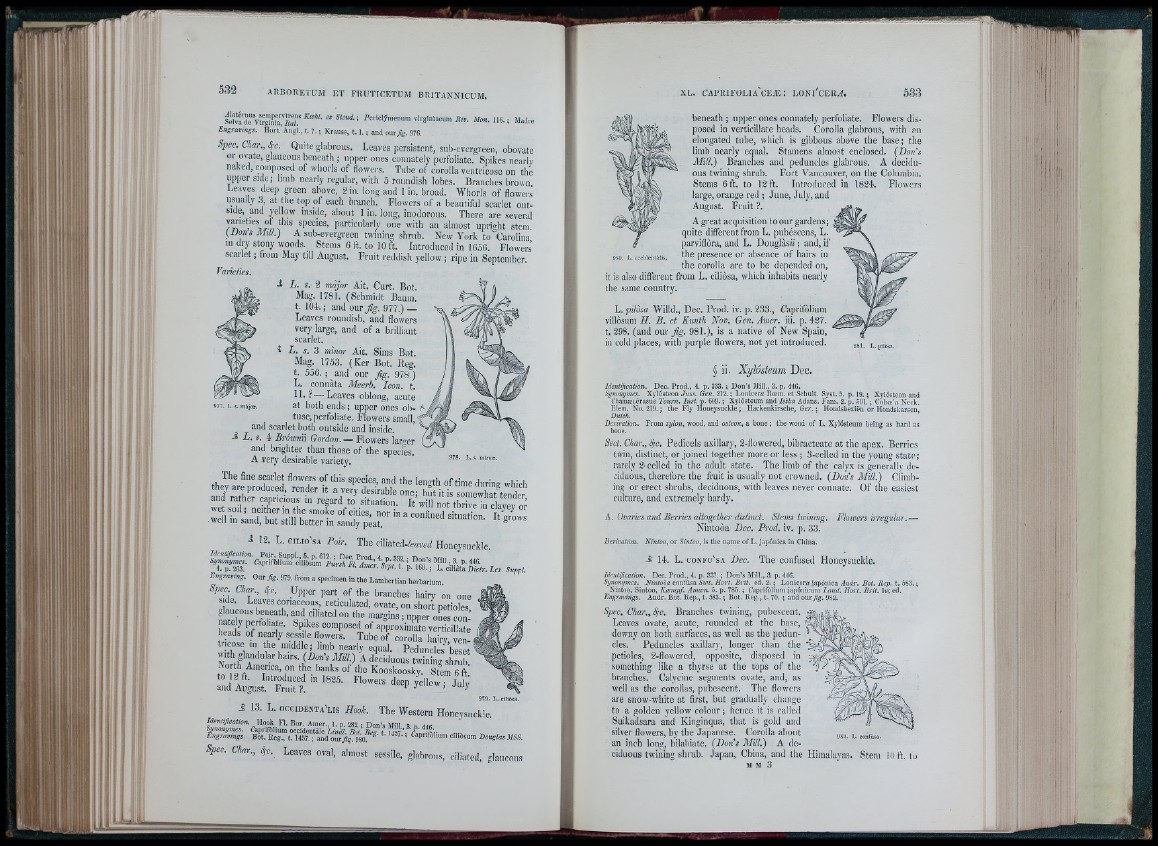
Periclÿmenum virginlacum iî/«/latérnus sempervìrens Kcchl. ex Sietià. î). Mon. iìG. ; Madre
Selva de Virginia, Hai.
Engràvings. fiori. Angl., l. ?. ; Krauss, t. I. ; and o u r .* . 976.
Spec. Char., f r . Quite glabrous. Leaves persistent, sub-evergreen, obovate
or ovate, glaucous beneath ; upper ones connately perfoliate. Spikes nearly
naked, composed of whorls of flowers. Tube of corolla ventricose on the
upper side; limb nearly regular, with 6 roundish lobes. Branches brown
Leaves deep green above, 2 in. long and 1 In. broad. Whorls of flowers'
usiuvliy 3, at the top of each branch. Flowers of a beautiful scarlet outside,
and yel qw mside, about 1 in. long, inodorous. There are several
varieties ot this species, particularly one with an almost upright stem.
{Dons Mill.) A sub-evergreen twining shrub. New York to Carolina
m dry stony wood.s. Stems 6 ft. to 10 ft. Introduced in 1656. Flowers’
scarlet ; from May till August. Fruit reddish yellow ; ripe in September.
Varieties.
977. L. s. màjor.
L. s, 2 major Ait. Curt. Bot.
Mag. 1781. (Schmidt Baum,
t. 10-i.; and our Jig. 977.) —
Leaves roundish, and flowers
very large, and of a brilliant
scarlet.
L. s. 3 minor Ait. Sims Bot.
Mag. 1733. (Ker Bot. Reg.
t. 556. ; and our Jig. 978.)
L. connata Meerb. Icon. t.
11.? — Leaves oblong, acute
at both ends ; upper ones ob- A
tuse, perfoliate. Flowers small, '
and scarlet both outside and inside.
Z.. s. 4 Browrm Gordon.— Flowers ¡arcer
and brighter than those of the species.
A very desirable variety. 978. L. s minor.
and rather capricious in regard to situation I t will nnf tRrRro • i ’
^ 12. L .oilio'sa Poir. The ciliated-Wed Honeysuckle.
Engraving, o .ir Jig. 979. from a specimen in the Lambertian herbarium.
Spec Char., f r . Upper part of the branches hairy on one
s de. Leaves coriaceous, reticulated, ovate, on short petioles
glaucous beneath, and ciliated on the margins ; upper o L s con!
nate y perfoliate. Spikes composed of approximate verticillate
heads of nearly sessile flowers. Tube bf corolla liairV ran
tiicose m the middle; limb nearly equal. Peduncles beset
with glandular hairs. {Don’s MUL) A deciduous twining s h ta ,
North America, on the banks of the Kooskoosky. Stem
r n d i t s t . " ‘F°ri-r?" ■"
A 13. L, OCCIDENTA'LIS Ilook.
979. L. ciliòsa.
The Western Honeysuckle.
Identification. Hook. Fl. Bctf. Amer., 1. p. 282 : Don’s Mill ^ r. aar
Spec. Char., f r . Leaves oval, almost sessile, glabrous, ciliated, glancons
I
9S0. L. cccideiJtàlis.
beneath ; upper ones connately perfoliate. Flowers disposed
in verticillate heads. Corolla glabrous, with an
elongated tube, which is gibbous above the base; the
limb nearly equal. Stamens almost enclosed. (Don's
Mill.) Branches and peduncles glabrous. A deciduous
twining shrub. Fort Vancouver, on the Columbia.
Stems 6 ft. to 12 ft. Introduced in 1824. Flowers
large, orange red ; June, July, and
August. Fruit ?.
A great acquisition to our gardens;
quite different from L. pubéscens, L.
parviflòra, and L. Douglás¿¿ ; and, if
the presence or absence of hairs in
the corolla are to be depended on,
it is also different from L. ciliòsa, which inhabits nearly
the same country.
L. pilòsa Willd., Dec. Prod. iv. p. 233., Caprifòlium
villòsum H. B. et Kunth Nov. Gen. Amer. iü. p. 427.
t. 298. (and our 981.), is a native of New Spain,
ill cold places, with purple flowers, not yet introduced. l. pi-òsa.
§ ii. Xylósteum Dec.
Identification. Dec. Prod., 4. p. 333. ; Don’s Mill., 3. p. 446.
Synonymes. Xylôsteon Juss. Gen. 212. ; Lonicera Roem. e t Schult. Syst. ñ. p. 19. ; Xylósteon and
Chamæcérasus Tourn. Inst. p. 609.5 Xylósteum and Isika Adans. Faro. 2. p. 501. j Coboe'a Neck.
Elem. No. 219. J the Fly Honeysuckle; Hackenkirsche, Ge r.; Hondsbezien or Hondskarsen.
Dutch.
Derivation, From xylon, wood, and osteon, a bone ; the wood of L. Xylósteum being as hard as
bone.
Sect. Char., 4c. Pedicels axillary, 2-flowered, bibracteate at the apex. Berries
twin, distinct, or joined together more or less j 3-celled in the young state;
rarely 2'Celled in the adult state. The limb of the calyx is generally’ deciduous,
therefore the fruit is usually not crowned. {Doris Mill.) Climbing
or erect shrubs, deciduous, with leaves never connate. Of the easiest
culture, and extremely hardy.
A. Ovaries and Berries altogether distinct. Stems hvlning, Flowers bregidur.—
Nintoòa Dec. Prod. iv. p. 33.
Derivation, Nintoo, or Sinioo, is tiie name of L. japónica in Cliina.
A 14. L. coN F u 'sA Dec. The confused Honeysuckle.
Identification. Dec. Prod., 4. p. 333. ; Don’s Mill., 3. p. 446.
Synonymes. Nintoòa contùsa Swt. Hort. Brit. ed. 2. ; Lonicera japónica Andr. Bot. Hep. t. 583. ;
Nintoo, Sintoo, Keempf. Amcen. 5. p. 785. ; Caprifòlium japónicura Loud. Hort. B rit. Iffc ed.
Engravings. Andr. Bot. Rep., t. 583. ; Bot. Reg., t. 70. ; and ourfig. 982.
Spec, Char., 4c. Branches twining, pubescent.
Leaves ovate, acute, rounded at the base,
downy on both surfaces, as well as the peduncles.
Peduncles axillary, longer than the
petioles, 2-flowered, opposite, disposed in
something like a thyrse at the tops of the
branches. Calycine segments ovate, and, as
well as the corollas, pube.scent. The flowers
are snow-white at first, but gradually change
to a golden yellow colour ; hence it is called
Suikacisara and Kinginqua, that is gold and
silver flowers, by the Japanese. Corolla about
an inch long, bilabiate. (Doris Mill.) A deciduous
twining shrub. Japan, China, and the liimalayas. Stem 10 ft. to
M M 3
93a. L. confiisa.
‘ ft ‘ i